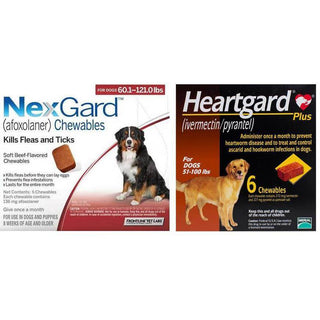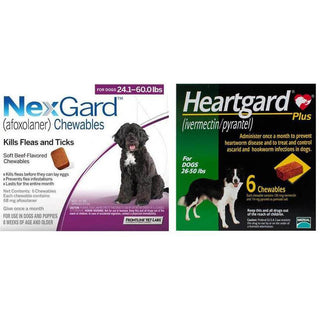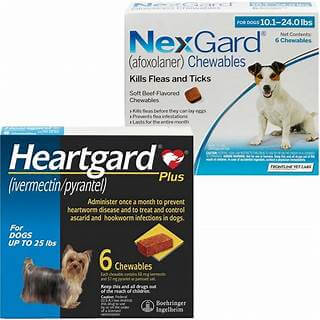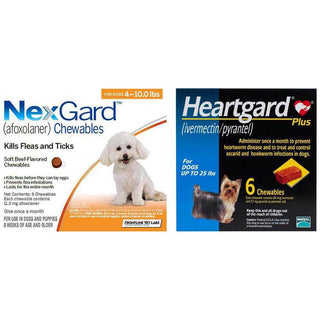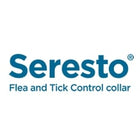
Common brand names
There is no product as a single ingredient.
Combined Ingredients
Nexgard Combo - esafoxolaner, eprinomectin, and praziquante.
Uses of Esafoxolaner
Esafoxolaner is a member of the isoxazoline class of compounds, which are used in veterinary medicine to treat and prevent parasitic infestations in animals. It acts as an ectoparasiticide, targeting external parasites like fleas and ticks.
-
Flea Treatment and Prevention:
- Kills adult fleas on pets quickly.
- Provides sustained flea control for up to a month after application.
- It helps break the flea life cycle by killing fleas before they can lay eggs.
-
Tick Control:
- It kills various tick species that may transmit diseases like Lyme disease.
- Offers protection against infestations for an extended period.
-
Broad-Spectrum Parasite Protection:
- When combined with other active ingredients (like eprinomectin and praziquantel in NexGard® COMBO), it provides additional protection against:
- Heartworms (Dirofilaria immitis).
- Gastrointestinal worms (e.g., roundworms, hookworms, and tapeworms).
- When combined with other active ingredients (like eprinomectin and praziquantel in NexGard® COMBO), it provides additional protection against:
Method of application
Esafoxolaner is administered externally as a spot-on/topical solution.
Dosage and administration
NexGard® COMBO is administered at a precise dosage of 0.055 mL per pound (0.12 mL per kilogram) of body weight. This ensures delivery of the following minimum active ingredient concentrations:
- Esafoxolaner: 0.65 mg/lb (1.44 mg/kg)
- Eprinomectin: 0.22 mg/lb (0.48 mg/kg)
- Praziquantel: 4.53 mg/lb (9.98 mg/kg)
Possible side effects
Nexgard Combo for Cats is very effective in treating internal and external parasites. However, some side effects of the Nexgard combo include diarrhea, excessive salivation, lethargy, vomiting, and skin reactions like itching and hair loss at the application site.
You will notice reactions immediately after application, and they are short-lived.
Precautions
Precautions need to be followed for use in your cats.
- Nexgard Combo is only for administration. Do not inject or give orally.
- Always avoid contact with your Cat's eyes, but if it did accidentally, please contact your veterinarian immediately.
- Make sure you apply Nexgard Combo where your Cat cannot lick it off, like on the neck between the shoulders.
- Ensure that you consult your vet before using Nexgard Combo for your Cat.
Precautions need to be followed for the person who is administering to the Cat:
- People with hypersensitivity to esafoxolaner, praziquantel, or eprinomectin should avoid contact with Nexgard Combo.
- The person who has applied should not eat, smoke, or drink after the application.
- Always avoid contact with your hands.
- If you get into contact with your hands, wash your hand properly with soap and water.
- It would be best to avoid contact with the site application until you don't notice it anymore or it's dry.
- It is recommended that you treat your Cat in the evening so there will be less contact with other people after the treatment of Nexgard Combo.
Signs of toxicity
Toxicity in pets can result from exposure to medications, chemicals, or substances in amounts exceeding safe levels. The signs of toxicity may vary depending on the toxin involved but commonly include:
General Signs of Toxicity:
-
Gastrointestinal Symptoms:
- Vomiting
- Diarrhea (sometimes with blood)
- Drooling or hypersalivation
- Loss of appetite
-
Neurological Symptoms:
- Tremors or shaking
- Seizures
- Weakness or paralysis
- Disorientation or confusion
- Loss of coordination (ataxia)
-
Respiratory Symptoms:
- Difficulty breathing
- Rapid or shallow breathing
- Excessive panting
-
Cardiovascular Symptoms:
- Irregular heart rate (arrhythmia)
- Pale or bluish gums
- Weak pulse
- Collapse or fainting
-
Dermatological Symptoms:
- Skin redness or rash
- Swelling (particularly at the site of topical application or ingestion)
-
Behavioral Changes:
- Restlessness or agitation
- Lethargy or depression
- Excessive vocalization (whining, meowing)
-
Urinary Symptoms:
- Increased or decreased urination
- Dark or discolored urine
-
Other Symptoms:
- Excessive thirst
- Hypothermia or hyperthermia
- Jaundice (yellowing of skin or eyes)
Storage
Maintain storage conditions between 59°F and 86°F (15°C to 30°C). Short-term exposure to temperatures up to 104°F (40°C) is acceptable. Ensure the product is kept away from direct light to preserve its effectiveness.
Disclaimer
This information is provided for general reference only and is not intended to replace the packaging label or veterinary advice. Always consult your veterinarian to ensure the supplied information applies to your pet. In addition, this page may not include all side effects, uses, brand names, or applications.


